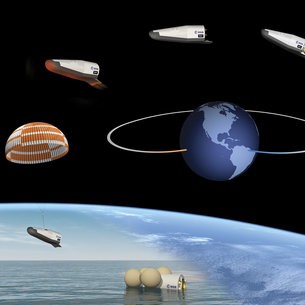ESA on the Verge of Building its Own Space Shuttle
| Marco Foronda | | Feb 15, 2015 01:54 AM EST |
(Photo : ESA) Artist's view of the IXV mission.
The European Space Agency (ESA) has successfully tested its IXV spaceplane, gathering valuable data for the construction of a future spacecraft capable of ferrying cargo and people between the Earth and orbiting spacecraft.
The unmanned Intermediate eXperimental Vehicle (IXV) launched above a Vega rocket from ESA's Kourou spaceport in French Guiana flew east around the globe and gathered information on how space objects fall to Earth.
Like Us on Facebook
The five meter-long, two-ton vehicle rose to an altitude of around 413 kilometers (257 miles) before splashing down in the Pacific Ocean to cheers from the mission control room in Turin, Italy.
Engineers will use the data in a range of future technologies, from re-usable rockets to Mars landers. ESA's IXV mission tested cutting-edge system and technology aspects. It will provide Europe an independent re-entry capability and a building block for reusable space transportation systems.
The IXV mission will validate designs for lifting-bodies, incorporating both the simplicity of capsules and the performance of winged vehicles with high controllability and maneuverability for precision landing.
IXV is a compromise between a shuttle and an Apollo-like capsule. The IXV, a one-off prototype that cost 150 million euros (US$170 million), used parachutes to land safely in the Pacific. But a future model based on its design could land at an airfield.
ESA has plans for a reusable spacecraft called PRIDE, but this project hasn't been approved yet.
The initial results from the IXV flight are expected to be released around six weeks later.
The results will feed the Programme for Reusable In-Orbit Demonstrator for Europe, or Pride, which is being studied under funding decided at ESA's last two ministerial councils.
TagsESA, spaceplane, Intermediate eXperimental Vehicle, ESA’s IXV mission, IXV mission, rocket launch, space exploration, cargo ship
©2015 Chinatopix All rights reserved. Do not reproduce without permission
EDITOR'S PICKS
-

Did the Trump administration just announce plans for a trade war with ‘hostile’ China and Russia?
-

US Senate passes Taiwan travel bill slammed by China
-

As Yan Sihong’s family grieves, here are other Chinese students who went missing abroad. Some have never been found
-

Beijing blasts Western critics who ‘smear China’ with the term sharp power
-

China Envoy Seeks to Defuse Tensions With U.S. as a Trade War Brews
-

Singapore's Deputy PM Provides Bitcoin Vote of Confidence Amid China's Blanket Bans
-

China warns investors over risks in overseas virtual currency trading
-

Chinese government most trustworthy: survey
-

Kashima Antlers On Course For Back-To-Back Titles
MOST POPULAR
LATEST NEWS
Zhou Yongkang: China's Former Security Chief Sentenced to Life in Prison

China's former Chief of the Ministry of Public Security, Zhou Yongkang, has been given a life sentence after he was found guilty of abusing his office, bribery and deliberately ... Full Article
TRENDING STORY

China Pork Prices Expected to Stabilize As The Supplies Recover

Elephone P9000 Smartphone is now on Sale on Amazon India

There's a Big Chance Cliffhangers Won't Still Be Resolved When Grey's Anatomy Season 13 Returns

Supreme Court Ruled on Samsung vs Apple Dispute for Patent Infringement

Microsoft Surface Pro 5 Rumors and Release Date: What is the Latest?










